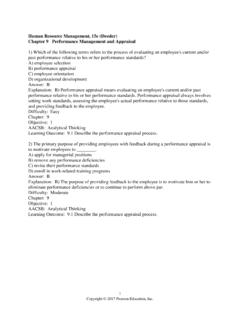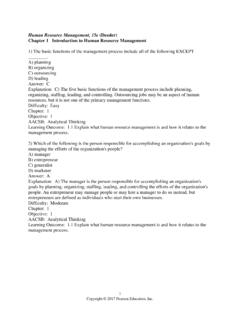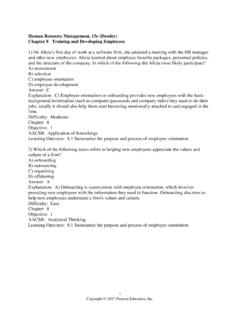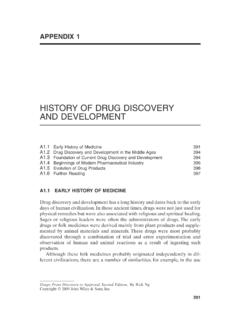Transcription of Lesson 6: Evaluating Performance - cbafaculty.org
1 Instructor guide Lesson 6: Evaluating Performance Lesson 6: Evaluating Performance PURPOSE. The purpose of Lesson 6 is to explain the Evaluating Phase; show how and why an employee should provide input to a final Performance appraisal discussion; describe the benefits of continuous feedback throughout the entire Performance appraisal cycle.; and show how shared understanding is the overall goal of Performance discussions. LEARNING OBJECTIVES. When participants have completed Lesson 6, they will be able to: 1. Recognize important facets of the Evaluating Phase. 2.
2 Describe how employees' inputs benefit the final Performance appraisal discussion. 3. Explain how to prepare for the Performance discussion. TOPICAL OUTLINE. A. Important facets of the Evaluating Phase. (1) Employee Ratings (2) Assessing accomplishments against the Performance plan (3) Level of Success B. Employees' inputs (1) Roles and Responsibilities (2) Employee Input and Evaluation C. Preparing for the Performance discussion (1) Performance Discussions (2) Performance Narratives (3) Resolving Differences 1 DPMAP July 2016. Instructor guide Lesson 6: Evaluating Performance TIME.
3 The following is a suggested time plan for this Lesson . The instructor(s) may adapt it as needed. Note this table does not reflect breaks use your judgement to determine the timing of breaks for participants. SESSION TIME. Lesson 6 - Evaluating Performance 45 MINUTES WITHOUT BREAK. 2 DPMAP July 2016. Instructor guide Lesson 6: Evaluating Performance Instructor Notes Content Lesson 6: Evaluating Performance SHOW SLIDE: 1. SAY. Welcome back. This is the start of Lesson 6: Evaluating Performance . SAY SHOW SLIDE: 2. These words represent the key messages that embody what is most important about New Beginnings Performance , mission, communication, excellence, etc.
4 DO. Display this New Beginnings slide at the beginning of each instructional day and during breaks. SAY SHOW SLIDE: 3. Before we begin, let's review the learning objectives for this Lesson . Upon completion of this Lesson , you will be able to: Recognize important facets of the Evaluating Phase. Explain how to prepare for the Performance discussion. Describe how employees' inputs benefit the final Performance appraisal discussion. DO. Leave this slide up while you discuss the topics that will be covered in this module. Paraphrase the learning outcomes; it is not 3 DPMAP July 2016.
5 Instructor guide Lesson 6: Evaluating Performance Instructor Notes Content necessary to read them verbatim. If the Lesson is being presented as a stand-alone Lesson , show all slides. If not, then consider hiding slides as appropriate. Additional Resources: L6 Employee Input Fact Sheet L6 Employee Input Tip Sheet Do's and Don'ts L6 Employee Input vs. Appraisal Fact Sheet L6 Employee Input Worksheet L6 Writing Employee Input L6 Performance Appraisal Discussion Checklist Resources listed above are located at: r-and-Employee-Relations/ Performance - Management/ Video: Lesson 6- End of Year Meeting video SAY SHOW SLIDE: 4.
6 As you'll recall from our previous lessons, Performance management is ongoing process and consists of several steps and phases. In this Lesson , we're going to look at the Evaluating Phase. SAY SHOW SLIDE: 5. Performance management is a process of Evaluating Performance 4 DPMAP July 2016. Instructor guide Lesson 6: Evaluating Performance Instructor Notes Content in a summary fashion. Evaluating Performance entails assessing Performance against the elements and standards in the employee's approved Performance plan and assigning a rating of record based on work performed during the Performance appraisal cycle.
7 DO. Do not read this slide. Instead talk over it while the participants read it. SAY SHOW SLIDE: 6. We will cover much of this in the next few slides, so just take a look for now. SAY SHOW SLIDE: 7. At the end of the Performance appraisal cycle, an employee's Performance is rated by their supervisor. Employees play an important role in the rating process as they document what they've accomplished and discuss those accomplishments during Performance discussions. Employee Performance is rated on what they've accomplished. This is done by Evaluating each element in an employee's Performance plan.
8 The employee then receives a rating of Outstanding, Fully Successful, or Unacceptable for each element. 5 DPMAP July 2016. Instructor guide Lesson 6: Evaluating Performance Instructor Notes Content SAY SHOW SLIDE: 8. DODI , Volume 431 provides some sample narratives based on rating being considered. DO. Give participant time to review and generate group discussion. SAY SHOW SLIDE: 9. As we mentioned previously, the goal of the Evaluating Phase is to have a final rating that comes as no surprise to either the employee or the supervisor. Employees should: Provide employee input: Employees' input describes how their contributions enabled mission accomplishment.
9 Another element of the employees' input may be achievements or recognition during the appraisal cycle as well as completed training and developmental courses. It should serve as a reminder to supervisors of significant accomplishments of their employees and can provide an opportunity for further discussion between the employee and supervisor and about employee Performance . Address each Performance element in the employee input. Employees should make factual, objective statements about how they accomplished each element. Ask: How do Performance elements relate to Performance 6 DPMAP July 2016.
10 Instructor guide Lesson 6: Evaluating Performance Instructor Notes Content standards? Answer: Performance elements define what an employee does;. Performance standards tell an employee how their Performance will be measured. Be sure wherever possible that your narrative about how the Performance elements were met uses similar language to the standard. That will help your supervisor connect the Performance dots. Restate the understanding of Performance elements. It never hurts to identify a difference in understanding of the Performance elements before the rating is finalized!














